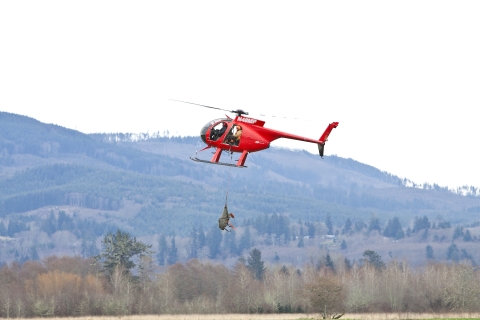This year is the 50th anniversary of the Endangered Species Act, a law that has been a powerful catalyst for conservation of America’s most treasured fish, wildlife, plants and their habitats. In the Pacific Region, our Tribes, state and federal agencies, and partners have joined with our dedicated staff to be the driving force behind the successes we share and the strength ensuring we can address the challenges ahead. Celebrate this milestone with us in this collection of stories as we reflect on past successes, assess current challenges, and envision an equally bright future for the next 50 years and beyond.
This story was originally published Oct. 12, 2016.
The first time I heard of the Columbian white-tailed deer was about four years ago. A few herds were in danger due to a faulty dike, which threatened to flood their home just off the Columbia River.
While the idea of capturing them and moving them to a new, safer home via helicopter sure sounded like a great adventure, it left me with one huge question: Why?
Nationwide, white-tailed deer are plentiful. Millions of white-tails are harvested annually by hunters for their tasty and healthy venison. They’re so numerous in some areas that they are problematic – overgrazing and overpopulating, foraging in neighborhoods on Aunt Matilda’s pansies and petunias.
I couldn’t understand why Columbian white-tailed deer needed the help of the U.S. Fish and Wildlife Service and its partners. Equally perplexing, why were they listed as an endangered species when they’re so plentiful nationwide?
I live a few miles from Ridgefield National Wildlife Refuge, which is where 88 Columbian white-tailed deer were translocated during the big deer airlift on Julia Butler Hansen Refuge for the Columbian White-tailed Deer.
Over the years, I’ve come to understand why they’re listed as endangered and need our help.
While white-tailed deer are common east of the Rocky Mountains, the Columbian white-tail (Odocoileus virginianus leucurus) is the only subspecies found west of the Cascade mountain range. There are 30 subspecies of white-tailed deer in North and Central America.
Columbian white-tailed deer are separated from the nearest subspecies in far eastern Oregon and Washington by hundreds of miles and a mountain range. The Columbian white-tailed deer generally resembles other white-tailed deer subspecies, ranging in size from 85 to 100 pounds for does (females), and 115 to 150 pounds for bucks (males). This is much smaller than the white-tails found in the Upper Midwest and Canada, which often exceed 300 pounds. The smallest subspecies is Florida’s Key deer, which only weighs up to 75 pounds.
In addition to the Columbian white-tailed deer, the more common Columbian black-tailed deer also is found in the Lower Columbia River basin.
The problems that caused the Columbian white-tailed deer to become endangered are the same issues that nearly wiped out white-tailed deer in the eastern United States in the early 1900s when there were as few as 300,000 white-tailed deer remaining. Habitat loss and modification by human activities, such as farming and logging, as well as commercial and residential development all played a role in their decline. Overhunting and poaching also contributed, though they played a more significant role in the population crash in the eastern United States. Today, there are up to 30 million white-tail deer nationwide.
Fortunately, things are also getting better for the Columbian white-tailed deer through collaborative conservation efforts between the Cowlitz Indian Tribe, the Washington and Oregon Departments of Fish and Wildlife, and the U.S. Fish and Wildlife Service.
The Douglas County population in the Umpqua River Basin of Oregon has recovered and was removed from the endangered species list in 2003. The Lower Columbia River population, which is found in Wahkiakum, Cowlitz and Clark counties in Washington, and Clatsop and Columbia counties in Oregon, has doubled its population from 450 in 1967 to more than 900 today.
Last year the Service proposed to reclassify the Lower Columbia River population of deer from endangered to threatened, meaning the likelihood of extinction had been reduced.
So here’s to hoping that these deer do as their eastern cousins did by recovering and repopulating. Maybe a few years from now we’ll see them in their historic range across the Willamette River and Cowlitz River valleys. I’ll gladly sacrifice all my pansies and petunias to see these deer grazing in my yard.







